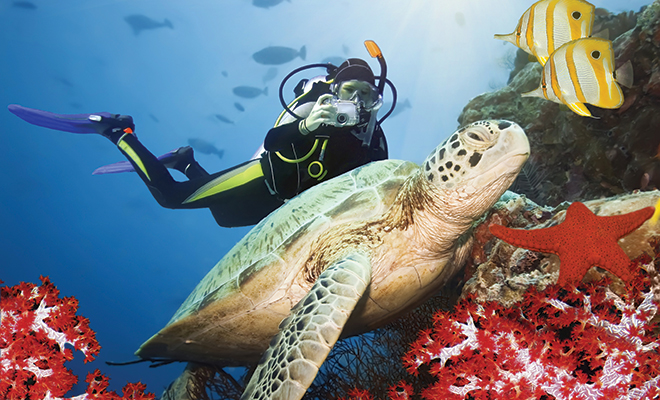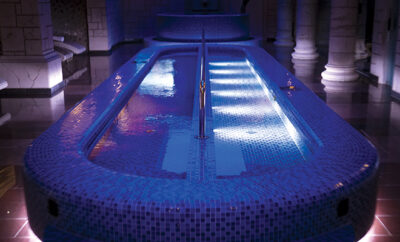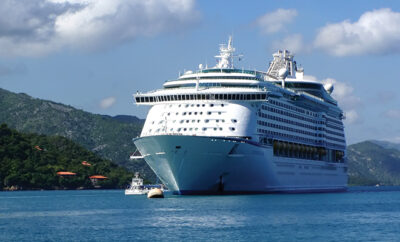
Dive Right In! Getting SCUBA Certified
Stingrays and sea turtles in the Cayman Islands. Coral reefs and tropical fish in the waters of Fiji. Dancing anthias and crinoids off Beatrice Reef in the Philippine Islands. Access to wilderness diving, spectacularly diverse marine topography and wildlife and a lifetime of discovery is yours through scuba certification.
B eyond exploring the most exquisite parts of the world, why else would you want to learn to dive? There’s relieving stress, getting a physical workout, reducing your blood pressure, upping your emotional well-being, improving your ability to concentrate and building lasting friendships with new dive buddies.
Getting Started
The Professional Association of Diving Instructors is a recreational diving membership and diver training organization founded in 1966. Its membership includes more than 135,000 dive professionals, 6,500 dive centers and resorts.
The National Association of Underwater Instructors is globally recognized for excellence in training and education. Many organizations specifically choose NAUI for their diver education programs, including Walt Disney World Resort in Orlando, Florida, United States Navy SEAL Teams and NASA’s Neutral Buoyancy Laboratory in Houston, Texas, where astronauts train for their space walks.
An internet search can quickly yield dive centers convenient to you. They’ll list the range of classes they offer and the investment required in class cost and equipment. Getting certified before your vacation will allow you to jump right in at your destination.
Structured Learning
Scuba certification includes three phases. First, you’ll learn the basic principles of diving, including planning dives, how to choose the right gear, underwater signals and other diving procedures.
Next, you’ll move to a pool or confined body of water to practice basic skills. You’ll learn to set up your gear, how to get water out of your mask, and how to enter and exit the water correctly. Buoyancy control, underwater navigation and safety procedures will be stressed. An instructor will practice with you until you’re comfortable in the water.
Finally, you’ll be ready for an underwater adventure at an open water dive site. You and your instructor will make four dives, generally over two days. You will apply the skills you have learned and enjoy the underwater environment. Your dive center will likely have locations close to home to complete this segment, but there are options through PADI and NAUI to finish training at your vacation destination.
Time Frame
Most courses are flexible and performance based; the length of time it takes depends on how fast you progress. Home study options through manuals and internet-based learning allow you to set your own pace for the basic knowledge portion.
Confined and open-water dive certification can be completed in three or four days. Your instructor is focused on helping you become a confident, comfortable and competent diver, as well as a safe diver.
Requirements
For certification, you will be required to complete a questionnaire about medical conditions that could be a problem during a dive. If any apply to you, your doctor must assess the condition and complete a form that confirms you’re fit to dive. Some local laws require all scuba students to consult with a doctor before beginning the course.
You must demonstrate basic water skills such as swimming 200 yards in mask, fins and snorkel without stopping and floating and treading water for ten minutes. Adaptive techniques permit individuals with physical challenges to meet these requirements; people with amputations, paraplegia or other significant challenges commonly earn certification.
Gear
Choosing gear is part of the fun. You will want to select, as a minimum, items that have a personal fit, such as a mask, snorkel and fins. While diving, you’ll learn to use a regulator, buoyancy control device, dive computer or dive planner, scuba tank, wetsuit or dry suit, weight system and submersible pressure gauge. You may prefer to invest in these items to be more comfortable with them.
Gear will differ depending on where you dive most. Tropical equipment, for diving in warm, clear water, differs from the equipment needed for diving in water cooler than 60 degrees Fahrenheit. If you continue with your dive adventure, you will likely want to invest in equipment for technical diving.
Where to Dive
That’s—wherever there’s water! It’s determined by your experience level, site access and condition. From lakes to oceans, rivers to springs, there’s a great site to practice your skills and enjoy nature.
The most important thing is to have training, experience and a dive buddy. Dive boats must display flags that indicate divers are in the water. If you’re diving from shore or from a personal watercraft, you can purchase a flag with a buoy or inflatable raft to keep the flag upright at the surface; you will tow this flag as you move.
Diving can revolutionize your next travel adventure—look into it! ■
Sources: nearsay.com, coastalliving.com, naui.org, padi.com, scubaventuresinc.com and thoughtco.com.







